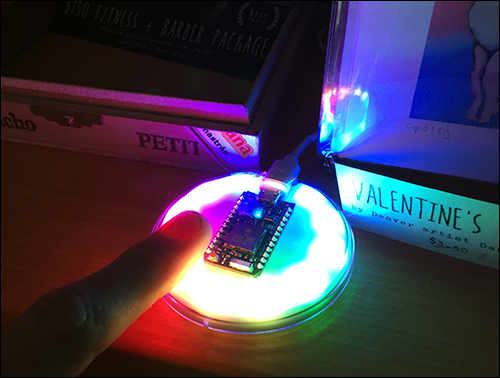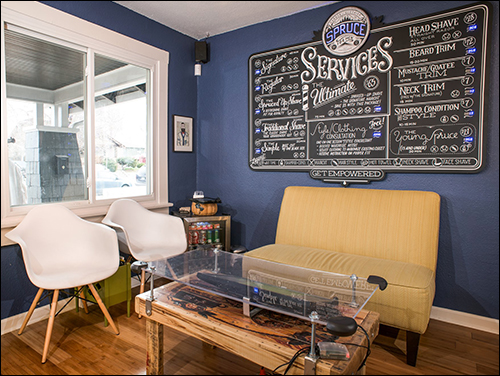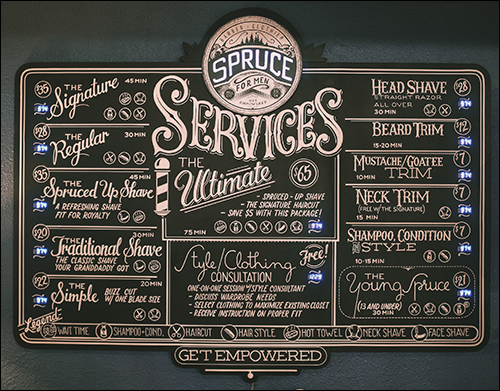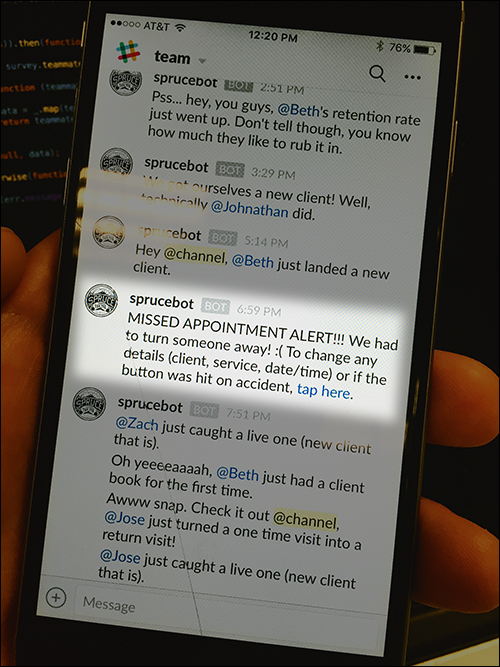A barbershop is just about the most antiquated retail setting most people can imagine. But most people have not been to Spruce, a men’s shop on Tennyson Street in Denver’s hip Berkeley neighborhood.
After more than a decade of working as a software developer at startups, Taylor Romero says he felt like a cog in a wheel and needed a change. And change came in spades when he and his wife decided to open a boutique menswear and barbershop in early 2015.
Romero knew nothing about running a barbershop. But he had recently read an article describing the Internet of Things and how, just as most consumers today can no longer count the items they own that have embedded microchips, soon they won’t be able to count how many objects they own that are internet-connected. This prompted Romero to start thinking about how the IoT was likely to impact every part of our lives. He says when he’d talk to peers about connecting things to the internet, he often heard retorts such as “Why would I want to connect my underwear, or my shoes, to the internet?”
But he realized that such responses were wrong-headed. “If someone is asking that,” he says, “you can be certain they are thinking about the problem in the wrong way. Connecting something to the internet is not the point—it is part of the solution to a problem.”
That became obvious to Romero not long after opening the shop, when he realized that the static menu board hanging over the barber’s chairs was failing to answer his customers’ chief question: “How long is the wait?”
Then he realized he had an available answer: connecting the menu board to the internet. “We had a whole online booking system; we had an API that told us our wait times and shows them on our website,” he says. “So we said, ‘Why don’t we just connect the damn menu board to the internet and answer that question right out of the gate?'”
Now, along with the types of cuts or shaves on offer, and their prices, customers also see a wait time, which appears via a small digital display next to each printed menu item.
Customers could get the answer to the wait-time question before, by pulling out their cell phones in order to access the store’s website and view the current wait time information listed in the booking application therein. But integrating the times into the menu board means waiting customers can view the information within a fraction of a second.
Wait times figured into another IoT solution to a problem as well, Romero says. When the shop first opened, demand was very high and the staff had to sometimes turn potential customers away if barbers were too backed up. Then, a potential investor with whom Romero was discussing the business asked him how he was optimizing his scheduling. If customers were being turned away, the shop was clearly not optimizing scheduling at all. So Romero purchased an internet-connected button (purchased online from Particle.io) and set it up near the cashier’s stand. Whenever a customer is turned away, either after walking into the shop or when calling to make an immediate appointment, an employee presses the button.
Romero programmed a link between the button and Slack, a workplace messaging app, so that whenever the button is pressed, all working employees receive a message on their phones, alerting them all that someone was turned away.
The person who pressed the button then taps the message to access Spruce’s appointment-management website, where she can either add in details (noting if the potential customer walked in the store or called, as well as any other notes that led to the missed sale) and what type of cut or shave that person wanted (since each service has a different price). The employee can also click a box to indicate that the button was pressed in error, thereby deleting the event.
In the Spruce appointments software, Romero programmed a simple graph that shows when the most customers are rejected (initially, the problem was particularly bad on Sunday afternoons). In addition, he beefed up staffing during those times in order to provide better coverage.
“We’re a small shop,” he says, “so being able to schedule efficiently is a big deal.”
Connecting Without Beacons
While Bluetooth beacons have emerged as a must-have tool for retailers looking to engage with customers, it’s not a technology Romero considered for Spruce. That’s because he does not believe his customers’ needs or interests would be met by having them download and use a special app on their smartphones.
“I’d love to use beacons, but who wants to add a native app to their phone just to get a haircut?” he asks.
However, Romero says, he did want to understand visiting patterns and be able to connect with returning customers. So he considered installing a Wi-Fi router in his shop that broadcasts a unique Server Set Identifier (or SSID, which Wi-Fi routers use to connect new devices to a network). This device would be designed to be used as part of a loyalty system, whereby customers, once their phones are identified, could be prompted to download a native app to receive special offers and more. Since Romero had already ruled out the use of apps, he instead designed a work-around.
The store already had a Wi-Fi router in place that it uses to provide internet service for the staff. So Romero utilized an Ethernet cable to connect the router to a Raspberry Pi, and to that device he added a Wi-Fi dongle that broadcasts its own SSID. He then programmed the Raspberry Pi so that the SSID appears as “spruce-guest.” In this way the Pi device acts as a secondary hotspot, designed just for customers.
Rather than using a login and password, customers can use their phones to book an appointment by providing only their smartphone numbers. Once Spruce receives a phone number, it sends that new customer a special link that he can open on his phone. This provides the customer with access to the booking system, where he can set up his profile and book an appointment.
Now, if a new customer who has booked an appointment this way enters Spruce and tries to connect to the store’s Wi-Fi network, the Raspberry Pi hotspot will send that person’s phone a prompt to enter his phone number in order to access the Wi-Fi.

On the back end, Romero’s program then links the MAC address of the customer’s device with that individual’s profile, based on the phone number presented. In this way, Spruce tracks every time the customer visits the store, because on subsequent visits, the phone will autoconnect to the shop’s Wi-Fi network, again transmitting the device’s MAC address.
Once a customer’s phone is set to autoconnect to the store’s guest Wi-Fi network upon entering the hotspot, workers will also receive a notification via Slack whenever that customer enters the store, along with his name and headshot (if provided when the profile was set up). They can use this information to greet the new arrival.
“You would be surprised how powerful it is to welcome [customers] to your shop by name,” Romero says.
But even if someone walks into the store and has never used the phone-based booking system, he can access the spruce-guest Wi-Fi network by providing his phone number and creating a profile on the spot.
“From there, we upped it a little more,” Romero states. “Now, when your phone autoconnects when you enter the store, we send you a link to a scratch-and-win game.” The prizes include such perks as a 10 percent discount on the customer’s next haircut.
This discount, once the customer unveils it (by “scratching” his phone screen), is linked to his profile, which is stored in Shopify, the point-of-sale management system Spruce uses. When the customer pays for his next haircut—which requires that the cashier first pull up his profile in Shopify—the reward will appear and be deducted from his tab. In this way, the customer need not remember to mention the discount.
Engaging—and Debugging—With Customers
Spruce also uses a bevy of other customer-interaction tools, including a touchscreen inside the boutique that allows customers to view exactly how much stock is available for any given item (selected from a list based on that product’s name), and in what sizes. The customer can then click on the size he wants, and a staff person automatically receives a text message asking for that item to be brought out.
Inside dressing rooms, Romero has installed Apple iPads that customers can use to change the lighting inside the room to match various settings (a beach, for isntance, or a club’s dance floor) by setting the LED lighting to pre-set levels and colors.
When a customer initially fills out his profile, he can include notes about how much he likes or dislikes chatting with his barber, and if he has any special needs. Fifteen minutes before his appointment, his barber will receive an alert with a link to the customer’s profile, so he can be best prepared to provide individualized attention.
When one new customer noted in his profile that he is deaf, Romero says, the barber who was to cut his hair greeted him at the door and introduced herself in sign language. “Thirty minutes later, when that customer left, I watched him take a selfie in front of the store sign,” says Romero, who later noticed that the customer had also made that photo his Facebook profile picture.
Customer loyalty goes even deeper than that for some people, who actually offer to help Romero debug any problems with the various systems at the store, where he also hosts periodic meetings of an IoT enthusiasts club. “People love to be engaged in the process,” he explains, “and they love when they give you an idea and then they see us implement it.”
Romero says he has considered adding RFID tags to the items he sells at the boutique, so that he could do such things as track inventory or make it easier and faster for customers to return the products they buy (assuming they leave the RFID tags on those items). However, he says, when he researched the price of RFID readers, he decided against that tack. “Maybe we’ll do that for store two or three,” he says, “but for now, RFID is far too expensive.”
In the meantime, Romero will probably keep tinkering and finding ways to make his business more efficient and engaging for customers.




